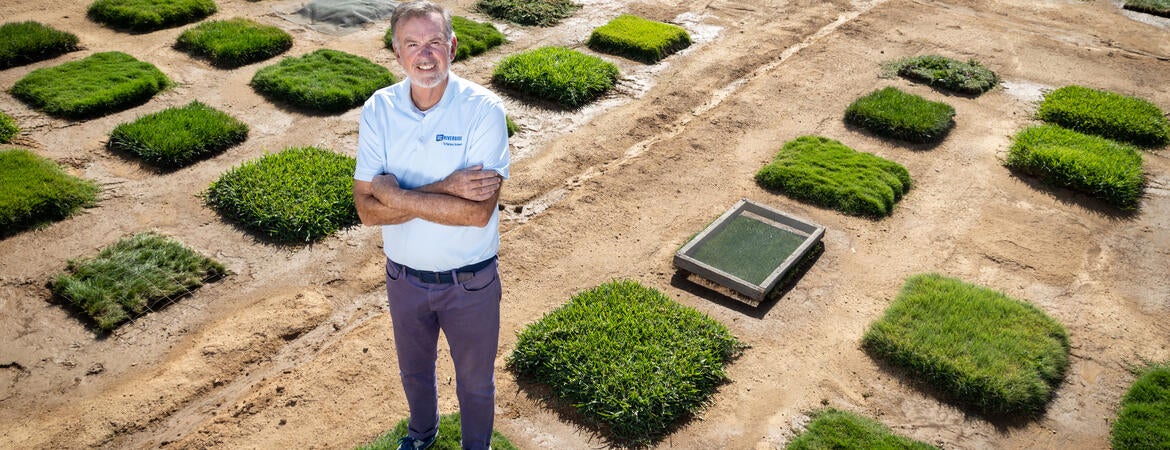Riverside, California, USA
November 25, 2024
UC Riverside has licensed a new drought-resistant bermudagrass cultivar that may well change the landscape of Southern California and beyond.

The agreement with licensee West Coast Turf will allow for the grass, which is being commercialized as Coachella™, to be available for purchase. The university’s Office of Technology Partnerships said West Coast Turf hopes to initially target golf courses and sports stadiums that require a large amount of real grass. Homeowners’ lawns will come later, as supply increases.
Coachella™ is not a scratchy, scrubby native groundcover stand-in for grass. It’s a less thirsty, greener-longer hybrid of the dominant turf for the California climate, bermudagrass. At UCR’s Agricultural Operations field, thin blades of the lush, green turf are on display in test plots, and in a large field.
“Coachella™ is the first bermudagrass to come from our recently resurrected turfgrass breeding program that exhibits our targeted traits of improved winter color retention, exemplary drought resistance above and beyond most existing bermudagrass cultivars and, of course, exceptional quality characteristics,” said Jim Baird, professor and cooperative extension specialist in turfgrass science.

Coachella™ is a hybrid bermudagrass and therefore largely sterile. It can’t be sold as seeds, only as sheets of sod or sprigs. For every square foot of sod or bushel of sprigs sold, UCR will receive a royalty based on a percentage of sales.
Coachella™ turf’s water-sipping ways turns up the volume on the argument to replace California’s most common lawn, tall fescue. Tall fescue is considered a “cool season” grass, which means it needs heavier watering in hot weather to keep it from turning brown.
Bermudagrass requires about 40% less water than tall fescue in the heat of the summer. The Coachella™ bermudagrass hybrid offers an additional 15 to 25% water savings from most other bermudagrass cultivars.
 Bermudagrass requires about 40% less water than tall fescue in the heat of the summer. The Coachella™ bermudagrass hybrid offers an additional 15 to 25% water savings from most other bermudagrass cultivars. Photos / Stan Lim
Bermudagrass requires about 40% less water than tall fescue in the heat of the summer. The Coachella™ bermudagrass hybrid offers an additional 15 to 25% water savings from most other bermudagrass cultivars. Photos / Stan Lim
Mel Williams, the chief financial officer for licensee West Coast Turf, said the first marketing target is golf courses — a couple already have expressed interest — followed by athletic fields and parks.
It will be early 2026 before West Coast Turf can offer Coachella™ turf to homeowners, at least at the scale for which it hopes. Coachella™ will be offered for sale either directly through West Coast Turf, or through big-box stores and other retailers.
Local government and water district incentives to remove lawns altogether in favor of xeriscaping, or dryscaping, presents a challenge in marketing drought-friendly Coachella™. The landscaping technique involves planting plants that don’t require much water to thrive.
Baird and other scientists argue xeriscaping is wrongminded against a backdrop of climate change.
“If we continue to rip out our lawns, that’s going to elevate temperatures, particularly in an urban environment,” Baird said.
School of Public Policy researcher Mehdi Nemati will publish research in early 2025 finding that grass removal leads to increased soil temperatures, with disproportionate impacts in low-income communities, where vegetation is already sparse.
“Removing (grass) is not the solution,” said Nemati, an assistant professor of environmental economics and policy whose research includes the intersection of drought and agriculture.
Coachella™ is a product of the UCR Turfgrass Breeding program, rebooted in 2012 after a long hiatus. It is the UC system’s only turfgrass program. There are programs at other universities, but, as Baird said: “We are developing grasses in California for California.”
Coachella™ is the first turfgrass licensed by UCR since 2000. The last turfgrass that generated significant royalty revenue for the university was called ‘El Toro’ zoysiagrass, licensed in 1986. ‘El Toro’ led to $1.6 million in royalty revenue for UCR, which places it among the university’s all-time top 10 royalty revenue-generating inventions.
When UCR develops turfgrass, it’s looking at several factors: pest tolerance, drought tolerance, how well it spreads, and its recovery from environmental and human impacts. But Baird said the biggest factor that drove Coachella’s™ development is what he calls "winter color retention."
“Californians don’t like brown or dormant grass; warm-season grasses like bermudagrass turn in the winter months,” Baird said. “Coachella™ is a significant step in the right direction in terms of maintaining better turf color and quality year-round with a lot less water. Essentially, we now have turfgrasses that use as little or less water than the so-called lawn replacement plants or groundcovers.”
Along with Baird, inventors listed on the Coachella™ patent are UCR professor and geneticist Adam Lukaszewski, and former and current UCR turf breeders Marta Pudzianowska and Christian Bowman, respectively.
Another as-promising turf with near-identical qualities to Coachella™ awaits its commercial premier, under the trademark of Presidio™. UCR’s Office of Technology Partnerships decided it would be best to market one new turf at a time, rather than both simultaneously.
Williams and West Coast Turf are big on Coachella™, and optimistic it may become the go-to lawn in Southern California and elsewhere.
“We’re literally just trying to grow it as fast as we can,” Williams said.
The UCR Office of Technology Partnerships is seeking international partners (ideally sod producers) to license and commercialize the Coachella™ bermudagrass outside the United States. Coachella™ would be ideal for regions that have similar climate and/or facing climate changes as California.
If interested, please contact Joyce Patrona, joyce.patrona@ucr.edu.